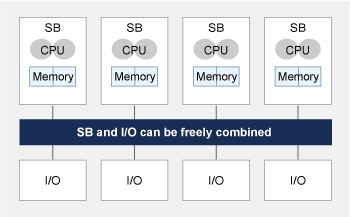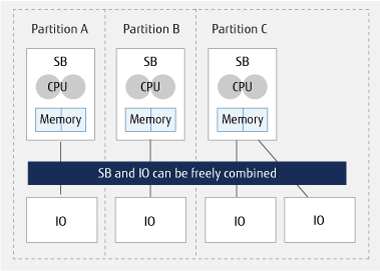Archived content
NOTE: this is an archived page and the content is likely to be out of date.
Flexible I/O and Partitioning
Switching I/O units from one System Board to another is very simple as each I/O unit integrates I/O functions such as PCI cards, internal storage, and other I/O ports. This means no configuration changes are required for such switching as the relevant I/O resources in the I/O unit are all switched together. In fact, the whole PCI bus tree visible from the system is not changed before/after I/O unit switching.
When recovering from a System Board failure, such simple I/O-unit-switching enables automatic fail over of the System Board.

Hardware Partitioning
Hardware Partitioning helps consolidate servers without performance overheads. This is because all system resources required for application operation can be split into electrically isolated partitions. This frees you from the elaborate design and testing typically required with most UNIX and x86 servers virtualization scenarios. This means there is no need for configuration design of virtual I/O and application performance tests.
PRIMEQUEST hardware partitioning helps you isolate applications from errors that occur as a result of hardware or software failures in other partitions. This makes it ideal for protecting database servers, where a failure would stop the entire system. This removes the problems of most UNIX and x86 servers, which typically do not support hardware partitioning. PRIMEQUEST supports mission critical applications as hardware failure does not cause the whole system to stop.
Flexible Resource Allotment
PRIMEQUEST can allot hardware resources according to each application's demands. In the following example, Partition C has larger I/O resources allotted on its I/O Board.




 01235 797711
01235 797711